
Although spinal manipulation can sometimes be helpful in treating mechanical-type neck and back pain, scientific consensus does not support the theory that adjusting vertebral subluxations will restore and maintain health. There is no credible evidence to indicate that manipulating the spine for any reason will improve general health or prevent disease:
It is unclear why some chiropractors feel the need to extend their scope of practice into implausible areas, when there is so much to do in the musculoskeletal field.
While a real orthopedic subluxation can cause musculoskeletal symptoms, a chiropractic subluxation alleged to cause nerve interference that contributes to the development of disease has not been proven to exist. Nevertheless, the chiropractic establishment and chiropractic entrepreneurs offer certification or a diplomate designation for many chiropractic treatment methods based on vertebral subluxation theory.
Instrument adjusting
Spinal manipulation is normally a hands-on procedure, used as an option in the treatment of a musculoskeletal problem. Chiropractors who subscribe to subluxation theory, however, might use a spring-loaded or electrically powered mallet to tap alleged vertebral subluxations into alignment as treatment for any ailment the patient might have. Such treatment usually includes a check of “functional” leg length to confirm the presence or the correction of a vertebral subluxation or a pelvic imbalance ─ a procedure that is as questionable as the theory underlying its practice.
Generic spinal manipulation in the form of manual high-velocity, low-amplitude thrusting on the spine can be helpful in relieving pain and restoring mobility in mechanically compromised back and spinal structures by stretching muscles and moving spinal joints to end range of movement and beyond. Use of a mallet to adjust a vertebral “subluxation” which may or may not exist cannot replace patient-tailored hands-on manipulative therapy as a treatment for musculoskeletal problems.
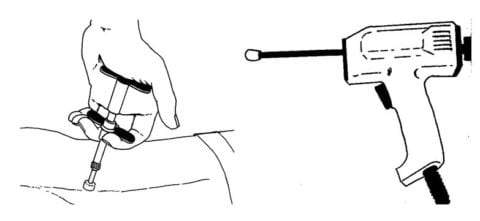
A variety of spring-loaded or electrically-powered mallets may be used in an attempt to correct vertebral subluxations, real or imagined.
When a hands-on spinal adjustment used to correct a putative vertebral subluxation (as a treatment for back pain or a health problem) cannot be done because of complicating factors (such as osteoporosis) or provider disability, an adjusting instrument might be used to satisfy the demand for an “adjustment.” Some subluxation-based chiropractors use adjusting instruments exclusively, treating every patient with a “clicker” and a leg-length check.
A 2005 publication by the National Board of Chiropractic Examiners reported that 40.3% of chiropractors used an adjustive instrument (Christensen. 2005). A proficiency rating in instrument adjusting can be obtained by passing written and practical exams after attending seminars offered by companies that produce such instruments.
Pediatric chiropractic
Perhaps the most egregious aspect of subluxation-based chiropractic care is the use of spinal manipulation on infants, a practice presently supported by both the International Chiropractic Association and the American Chiropractic Association. Some chiropractors believe that a baby’s vertebrae are commonly subluxated by the birthing process, especially the atlas (uppermost neck) vertebra, causing a variety of childhood ailments. There is no evidence that such subluxations occur; if they do, they should not be subjected to manipulation.
The American Chiropractic Association’s Council on Chiropractic Pediatrics supports chiropractic treatment of infants and pre-adolescent children:
Studies are beginning to show that chiropractic can help children not only with typical musculoskeletal complaints but with somatovisceral issues as varied as asthma, chronic ear infection, breast-feeding difficulties, colic and bedwetting.
The International Chiropractors Association Council on Chiropractic Pediatrics explains how chiropractic care is supposed to help children:
The doctor of chiropractic, through a procedure called an adjustment, helps restore misaligned vertebrae to a more normal position, thus allowing the nerves to properly communicate with the rest of the body and let the body heal itself─safely and naturally.
It is simply not possible to detect subluxations by palpating the fat-padded cartilaginous spine of an infant or a small child. “Subluxations” located by finger-tip examination of a baby’s neck are undoubtedly a product of imagination or deception. Some pediatric chiropractors palpate and manipulate a baby’s spine soon after birth to correct subluxations ─ a dangerous and unnecessary practice.
The cartilaginous vertebral growth centers in children under 8 to 10 years of age are most vulnerable to injury caused by spinal manipulation (not to mention the risk of stroke). Such injury may not be detectable and could conceivably result in growth-plate fractures or injury to epiphyseal cartilage that might result in such pre-adolescent deformity as scoliosis or Scheuermann’s kyphosis.
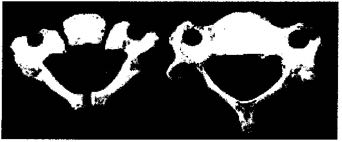
The image on the left shows radiolucent cartilaginous ossification centers in the thoracic vertebra of a 1-year-old child, compared with the partially ossified thoracic vertebra of a 6-year-old child. Injuries caused by inappropriate spinal manipulation are most likely to occur in children under 6 to 8 years of age, and may not be detectable.
Pediatric chiropractors maintain that the light finger-tip pressure used to adjust a baby’s spine could not possibly cause injury. Any pressure sufficient to move vertebrae, however, may cause occult injury in the partially formed vertebrae of a baby. Although most baby “adjustments” appear to be nothing more than harmless pretense (perhaps providing the nurturance of touch), a plethora of You Tube videos showing chiropractors manipulating the spine of a baby clearly show use of techniques that produce extreme movement of vertebrae with the popping sounds caused by cavitation.
There is no known benefit to be gained from manipulating the immature spine of a newborn baby or an infant. In keeping with views of medical professionals, a neurosurgeon has advised that “potential complications and unknown benefits indicate that SMT [spinal manipulative therapy] should not be used in the pediatric population.”
Injury to children as a result of pediatric chiropractic care may not be limited to the spine. A recent study by orthopedic surgeons (discussed last week by SBM’s Jann Bellamy) found chiropractic-related injuries involving a variety of orthopedic problems, such as hip dysplasia. “Delayed referrals, misdiagnoses, adverse events from manipulative therapy, and ineffective treatments” were observed.
Training and qualifications for designation as a pediatric chiropractor are clearly far from adequate. The International Chiropractic Association offers a post-graduate Diplomate in Clinical Chiropractic Pediatrics (DICCP). The diplomate syllabus is a 30-module, 360+ hours of classroom study during weekends. There is no hospital training and no contact with diseased or injured children.
Webster Technique
The Webster Technique, an offshoot of pediatric chiropractic, is a method of adjusting the sacroiliac joints to assure normal delivery of a baby, a technique claimed to be capable of turning a breech baby in the womb. According to the International Chiropractic Pediatric Association:
The Webster Technique is a specific chiropractic sacral analysis and diversified adjustment. The goal of the adjustment is to reduce the effects of sacral subluxation/SI [sacroiliac] joint dysfunction….Sacral subluxation may contribute to difficult labor for the mother (i.e., dystocia) caused by inadequate uterine dysfunction, pelvic contraction, and baby mal-presentation. Correction of sacral subluxation may have a positive effect on all these cases of dystocia.
Although the sacroiliac joints are routinely adjusted by Webster practitioners to correct a “subluxation,” sacroiliac subluxation is rare. The sacroiliac joints are tightly fitted synovial and fibrous-filled joints with irregular, interlocking joint surfaces that are bound together by dense, strong ligaments. Although there is some movement in sacroiliac joints, they are rarely subluxated (in the orthopedic sense) unless there is ligamentous injury. Sacroiliac pain is most often the result of strain or inflammation.
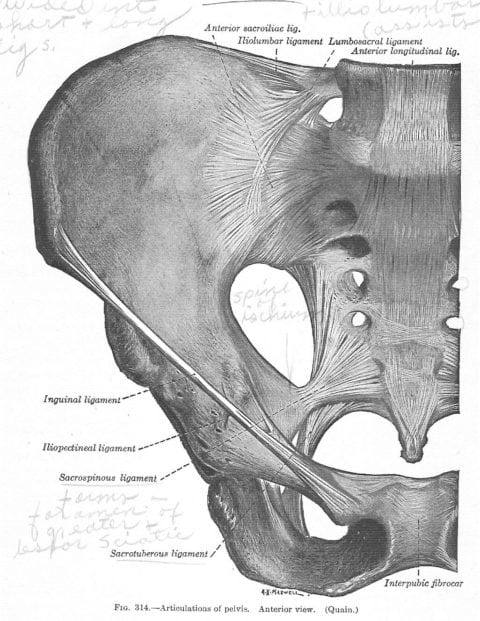
Tightly fitted interlocking sacroiliac joints are bound together by strong ligaments. Illustration: Gray’s Anatomy.
Child birth is facilitated by production of a hormone called relaxin, which relaxes sacroiliac and pubic ligaments in order to allow the baby to pass through the pelvis. During pregnancy and post-partum recovery, relaxed sacroiliac ligaments are most vulnerable to strain or injury, which might occur as a result of inappropriate or unnecessary sacroiliac manipulation.
It defies logic to assume that manipulating a putative sacroiliac subluxation, or tapping on a sacroiliac joint with a spring-loaded mallet, can be an effective way to turn a breeched baby in the womb. In most cases, a baby will turn from a breech position to a normal vertex (head down) position by the end of the 8th month anyway, providing the chiropractor with “proof” that the Webster Technique was an effective treatment.
Certification in Webster Technique requires attendance at 14 seminars and participation in 2 research projects. Advanced instruction for a diplomate in prenatal care (DACCP), awarded by the Academy Council of Chiropractic Pediatrics, requires 400 hours of weekend classroom instruction ─ instruction that is certainly not adequate to diagnose and handle potential complications of pregnancy and delivery.
NUCCA techniques
Although most subluxation-based chiropractors adjust subluxations in every portion of the spine, either manually or with an instrument, some chiropractors specialize in adjusting the atlas vertebra at the top of the spine. These chiropractors, most of whom are members of the National Upper Cervical Chiropractic Association (NUCCA), believe that the misalignment of the atlas places pressure on the brain stem and is responsible for subluxations from the neck down, causing the gamut of human ailments.
The focus of the NUCCA work is the relationship between the upper cervical spine (neck) and its influence on the central nervous system and brain stem function. It is this relationship that affects every aspect of human function from the feeling sensations in your fingers to regulating hormones, controlling movement, and providing the ability to hear, see, think, and breathe… The supine leg check, which shows leg length inequality, is the basic standard to determine if you have an upper cervical misalignment.
The Blair Upper Cervical Technique does not require a diagnosis as a prerequisite for treatment:
The purpose of the Blair Upper Cervical Chiropractic Technique is not to diagnose or treat diseases or conditions, but to analyze and correct vertebral subluxations in an accurate, precise and specific manner to allow the body’s intelligence to mend, repair and maintain health from within.
A Certificate of Proficiency in NUCCA requires seminar instruction, testing in x-ray analysis and other procedures for reducing an “Atlas Subluxation Complex,” and membership in the National Upper Cervical Chiropractic Association. Completion of “Level Three” testing is required to be Board Certified in NUCCA. Upper cervical specialists may use a variety of techniques, such as Blair Upper Cervical, Atlas Orthogonal (see image below), or HIO (hole-in-one) Toggle.
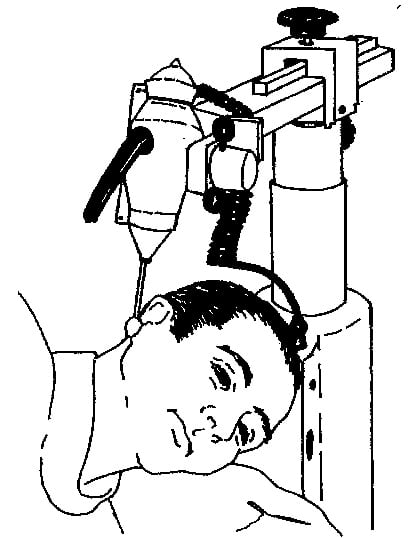
An orthogonal technique uses the “percussion sound vibration” of a stylus to realign the atlas vertebra.
Note: While fixation of the atlas (a rare occurrence) can occur and might be relieved by appropriate manipulation, the alignment of a freely movable atlas (or any vertebra) cannot be changed. When an atlas is moved by an “adjustment,” it always returns to its normal resting place, as dictated by anatomical factors, such as the configuration of joint surfaces. There is no scientific rationale or justification for repeated manipulation of the atlas to correct or prevent a “subluxation.”
It should be further noted that upper cervical manipulative techniques that force extreme rotation of the atlas pose a risk of stroke ─ albeit rare ─ by injuring vertebral or internal carotid arteries.
Applied kinesiology
The International College of Applied Kinesiology says that:
Applied Kinesiology (AK) is a system that evaluates structural, chemical and mental aspects of health using manual muscle testing combined with other standard methods of diagnoses.
Applied kinesiology, developed by a chiropractor, is a nonsensical technique used to detect and treat health problems (and vertebral subluxations causing health problems) by testing strength in certain muscles. Detecting and curing nutritional deficiencies and allergies, for example, can supposedly be done by placing a substance in a patient’s mouth, in one hand, or some place on the body and then testing muscle strength, most often by placing downward pressure on an extended arm. Weakness in a deltoid muscle would indicate a cause of the problem while strength would suggest a cure. A search for the cause and the cure of a health problem in a child may be done by placing the child on the mother’s body and then testing the strength of certain muscles in the mother.
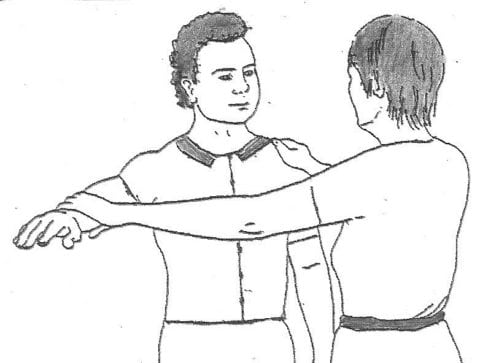
Testing deltoid strength while a food substance is in the subject’s mouth may be used to determine if the substance is helpful or harmful to the body.
Testing for weakness in a muscle believed to be associated with disease in an organ or a subluxation causing the disease is an arbitrary procedure that may be influenced by suggestion, an ideomotor effect, chicanery, changes in leverage or pressure, by distraction, or by the bias of practitioner assessment.
Chiropractors can obtain a diplomate in applied kinesiology (DIBAK) from the International College of Applied Kinesiology by passing a written exam after attending 300 hours of instruction followed by 3 years of kinesiology practice. Applied kinesiology is not the same as the science of kinesiology (the study of movement in muscles).
A final word: Since chiropractic is defined as a practice focused on vertebral subluxations as a cause of “reduced function, disability, or illness” (Christensen. 2015), questionable claims made for methods based on chiropractic subluxation theory remain unchallenged by the chiropractic establishment.
Unfortunately, subluxation-based chiropractic provides a simple path for true believers who have been indoctrinated in vertebral subluxation theory; it may also provide opportunity for self-serving individuals who choose to forego the rigorism of science in assuming responsibility for care of the sick and disabled.
I wish the best for those chiropractors who reject vertebral subluxation theory and who follow the guidelines of science in offering appropriate care for musculoskeletal conditions.

References
- Christensen MG, MW Kollasch, R Ward, et al. 2005. Job Analysis of Chiropractic. National Board of Chiropractic Examiners. Greeley, CO.
- Christensen MG, JK Hyland, CM Goertz, et al. 2015. Practice Analysis of Chiropractic 2015. National Board of Chiropractic Examiners. Greeley, CO.

